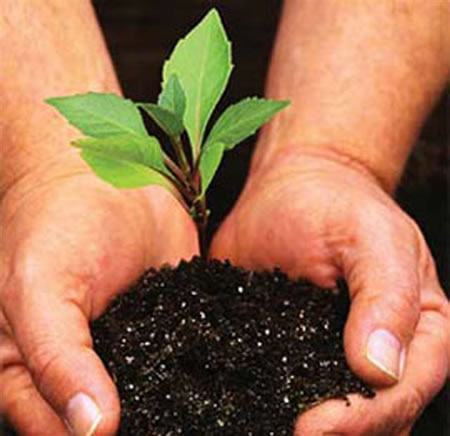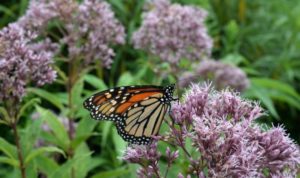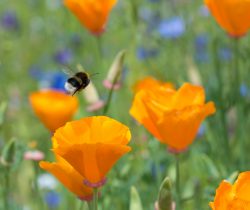Sure you can.
Here’s how:
1) Scope out possible planting locations. Trees need room for both branches and roots to spread out, so adequate space is key. So is good soil. Is yours loose and loamy, or dense and full of clay? And what about water? Is your spot high and dry or low and prone to flooding? The place you pick determines what tree will do best in your yard.
2) Choose your tree. Consider how big the tree will get and how fast it will grow, as well as its sun, soil and water requirements. Arbor Day’s ‘right tree in the right place’ guide will help you find options that work for your “micro” climate. Consider species native to your area to help promote biodiversity.
If you live in a zone that is prone to drought, one of these trees could do well:
Silver maple
Chinese elm
Red oak
Purpleleaf plum
If your region gets a lot of moisture, one of these trees would be better:
River birch
Weeping willow
Austrian pine
3) Put your tree in the ground. How you plant a tree will depend on whether the roots are bare, wrapped in burlap, or potted in a container. Regardless, you’ll need to dig a hole that’s deeper and wider than the roots and add aged compost. After your tree is in the ground, clear grass at least three feet away from the trunk in every direction and mulch with wood chips or shredded bark to help the roots retain moisture and act as a buffer against temperature extremes. Water deeply upon planting, then regularly until the tree roots get established.
If you like to do things from scratch, you can plant a seed. Again, consider seeds that are native to your location. You might want to start the seed in a container so you can nurture it along over the couple of years it will take to grow into a seedling you can transplant. Fill a one- or -two gallon container with dirt that contains some rich organic matter, then make a hole about 1 inch deep, pop in the seed and cover with soil. It doesn’t get easier than that.
Once you plant a tree, keep it healthy so you can enjoy all the benefits it offers. It will attract birds and other wildlife, and provide shade to keep you cooler in summer. The leaves will help filter soot and dust, clearing the air, and convert carbon dioxide back into oxygen, reducing global warming and climate change. Plus research shoes that trees and the sound of their leaves tend to make people feel more relaxed. In fact, hospital patients recover more quickly when their room offers a view of trees! Having some trees to look out on from your porch or patio could have an equally calming effect on you.
RESOURCES:
If you don’t have enough space in your own yard to accommodate a tree, plant one in your community. Work with your local public works department to choose a species or location.
Or support global tree planting campaigns, like the one Avon is running through its Hello Green Tomorrow program.
Some cities, like Pittsburgh, require residents to obtain a tree planting permit. You may want to check to see if this is the case where you live.
For more information on tree planting and organizing community planting in your area visit American Forests or Sustainable Horticulture.
For gardening supplies, visit our store.
(Disclosure: I provide green living tips to Hello Green Tomorrow.)
(Thanks to research assistant Tracy Gaudet of Inspire Planning for research help.)



















5 thoughts on “It’s Arbor Day. Can’t you plant just one tree?”
Great article from @biggreenpurse! You can also help the environment by helping us plant up to 10,000 trees. We’ve teamed up with the Arbor Day Foundation® in an effort to plant up to 10,000 trees across the nation. If you plant a tree in our new Trees of Tomorrow virtual forest, the Arbor Day Foundation® will plant a real one in your honor. 🙂
Global warming is getting worse. We cannot prevent it anymore for it has hit us. All we can do is to minimize it. Let me share to you some reasons why we need to plant more trees.
1.
Alleviating the “Greenhouse Effect,” trees act as carbon “sinks.”
1 acre of new forest will sequester about 2.5 tons of carbon annually. Trees can absorb CO2 at the rate of 13 pounds/tree/year. Trees reach their most productive stage of carbon storage at about 10 years.
In its “Reforesting the Earth” paper, the Worldwatch Institute estimated that our planet needs at least 321 million acres planted to trees just to restore and maintain the productivity of soil and water resources, meet industrial and fuel-wood needs in the third world, and annually remove from the atmosphere roughly 780 million tons of carbon as the trees grow. This 780 million tons represents the removal of about 25 percent of the 2.9 billion tons of carbon currently going into the earth’s atmosphere.
Planting 100 million trees could reduce the amount of carbon by an estimated 18 million tons per year and at the same time, save American consumers $4 billion each year on utility bills.
For every ton of new wood that grows, about 1.5 tons of CO2 are removed from the air and 1.07 tons of life-giving oxygen are produced. During a 50-year life span, one tree will generate $30,000 in oxygen, recycle $35,000 worth of water, and clean up $60,000 worth of air pollution or $125,000 total per tree without including any other values!
2. Prevents or reduces soil erosion and water pollution.
3. Helps recharge ground water and sustains streamflow.
4. Properly placed screens of trees and shrubs significantly decrease noise pollution along busy thoroughfares and intersections.
5. Screen unsightly views.
6. Soften harsh outlines of buildings.
7. Provide fuelwood for stoves and fireplaces by establishing energy plantations of hybrid poplars and other fast-growing species and managed on a sustained yield basis for a continuous supply of fuelwood.
8. Properly managed forests provide lumber, plywood and other wood products on a sustained yield basis.
9. Depending on location, species, size, and condition, shade from trees can reduce utility bills for air conditioning in residential and commercial buildings by 15-50 percent. Trees, through their shade and transpiration, provide natural “low-tech” cooling that means less need to build additional dams, power plants, and nuclear generators.
10. Windbreaks around homes can be shields against wind and snow and heating costs can be reduced by as much as 30 percent.
11. Shade from trees cools hot streets and parking lots. Cities are “heat islands” that are 5-9 degrees hotter than surrounding areas. And cities spread each year.
12. Trees and shrubs properly placed and cared for on a residential or commercial lot can significantly increase property values.
13. Numerous research studies conducted in the Great Plains States have found that properly placed and cared-for field windbreaks will significantly increase crop yields compared to fields with no windbreaks, even after taking into account the space occupied by the trees. Windbreaks create a more favorable micro-climate for cropland by reducing wind and heat stress on the crop, while at the same time preventing topsoil loss and reducing soil moisture losses. During the winter, more moisture is available for use later in the year since windbreaks trap and accumulate snow that, without windbreaks, would have blown over and past the cropland and end up on roads and other breaks in topography.
14. Farmstead windbreaks have many values including reduction of utility bills for cooling and heating, snow entrapment, wind reduction, aesthetics, and wildlife habitat.
15. Trees also provide nutmeats (walnuts, pecans, hickory), fruit (plum, peaches, apples, pears), berries for jams and jellies (chokecherry and buffaloberry) and maple syrup.
16. Tree shelters for livestock effectively reduce weight losses during cold winter months and provide shade for moderating summer heat.
17. Living snowfences, strategically placed, hold snow away from roads, thus effectively reducing road maintenance costs and keeping roads open.
18. Trees add beauty and grace to any community setting. They make life more enjoyable, peaceful, relaxing, and offer a rich inheritance for future generations.
19. Tropical forests, in addition to their value for winter range for migratory birds, wood products, etc., are extremely value for healing purposes. One of every four pharmaceutical products used in the U.S. comes from a plant found in a tropical forest. However, the majority of tropical plants have not yet even been scientifically screened to discover what healing powers they may offer.
20. Likewise, substances found in native trees in the U.S. are used both for pharmaceutical and other medical purposes. The most recent example is the Pacific yew tree found in the coastal regions of southeastern Alaska, British Columbia, Washington, Oregon, and northern California and inland areas of northern Idaho and western Montana. Experiments conducted at the National Cancer Institute for the past 10 years have shown that taxol, a drug extracted from the bark of the Pacific yew, is effective in treating cancer. One of the Institute’s chemists stated recently, “We have found taxol to be the most effective product in curing ovarian cancer. So far, 30 percent of our patients have had a total remission or cure.” The USDA Forest Service is now cooperating with the Institute by inventorying areas in the States mentioned earlier. Cuttings from those areas were taken last fall, shipped to several Forest Service nurseries, and are now starting to grow in their greenhouses. The National Cancer Institute is conducting tests on this plant material to determine which individual yew trees will produce the highest volume of taxol. After selections are made, plantations of these high- yielding trees will be grown for future use in fighting cancer.
21. Trees give people a multitude of recreational opportunities and provide habitat for wildlife.
22. Trees along rivers, streams, and lakes reduce water temperatures by their shade, prevent or reduce bank erosion and silt, and provide hiding places for improving fisheries habitat.
23. They provide brilliant colors to landscapes in the fall. After the leaves drop to the ground and are raked, they provide excellent mulch for flowerbeds and gardens as well as exercise for people.
24. Research indicates that trees help reduce stress in the workplace and speed recovery of hospital patients.
25. Police officers believe that trees and landscaping can instill community pride and help cool tempers that sometimes erupt during “long, hot summers.”
26. Trees help us experience connections with our natural heritage and with our most deeply held spiritual and cultural values.
27. Trees are valuable as commemoratives of deceased loved ones and for passing on something of value to future generations.
28. A tribe of South American Indians believes that the trees of the forest hold up the sky. According to the legend, the fall of trees will precipitate the downfall of the Earth.
29. Finally, many people enjoy planting and caring for trees simply because they like to see them grow.
that’s a good idea..it might be help to our environment or to our mother nature..Let share it to everyone..nice selection..
I admire you for supporting this advocacy! Global warming is not a myth. It is a reality we have to face and soon. It’s never too late to stop it if we act united.
Good stuff as per usual, thanks. I do hope this kind of thing gets more exposure.
Comments are closed.